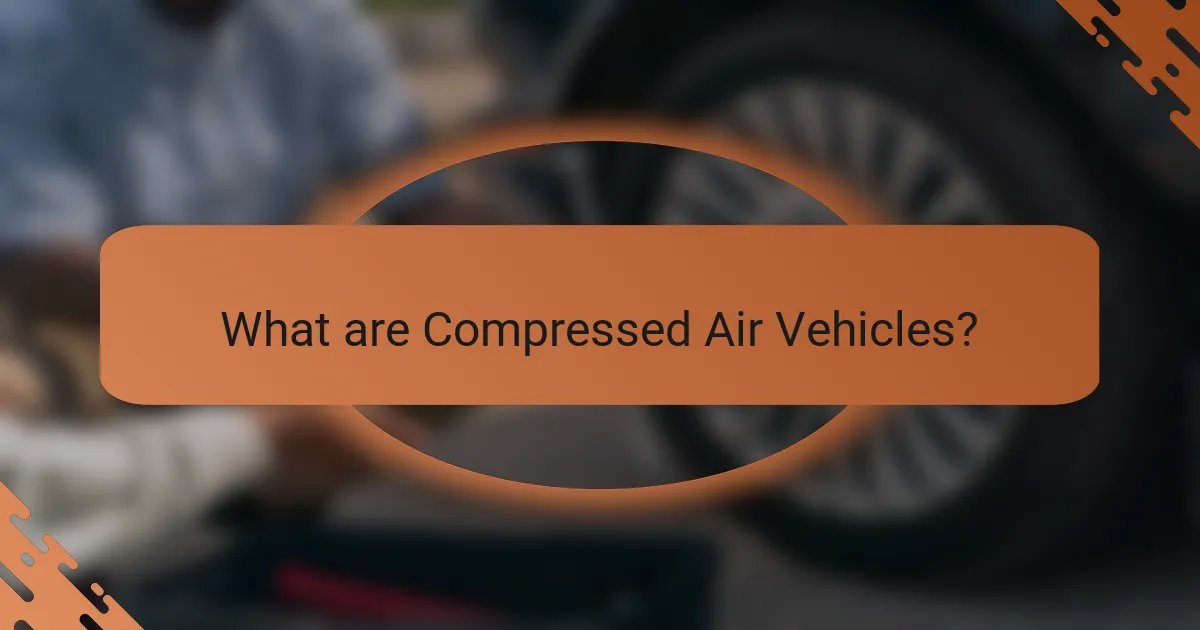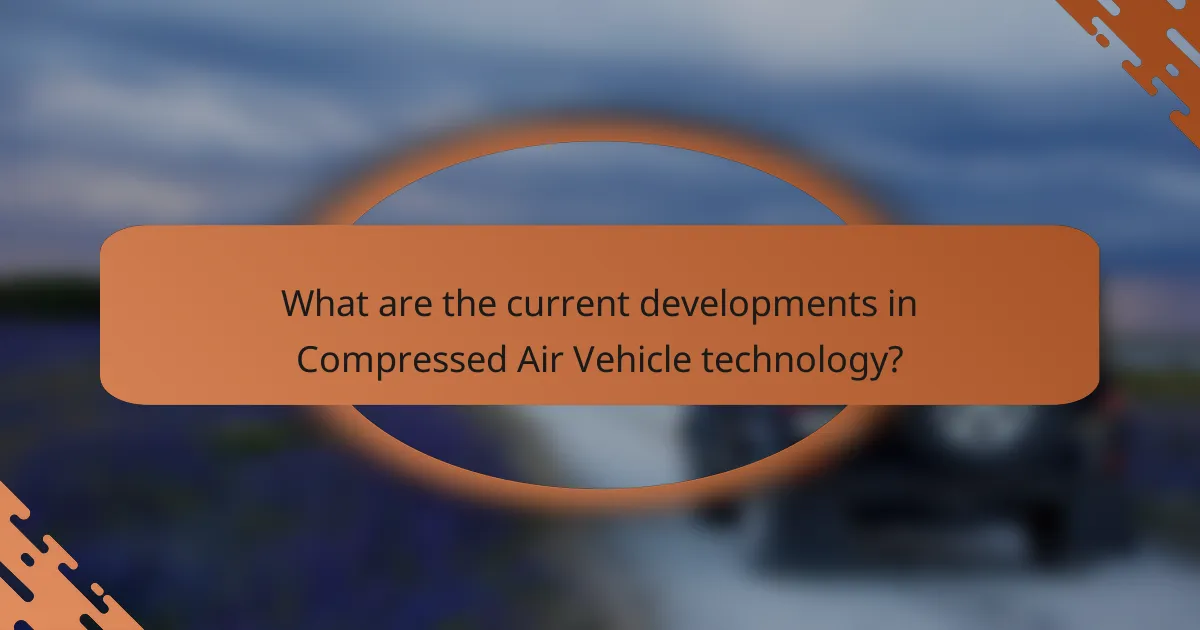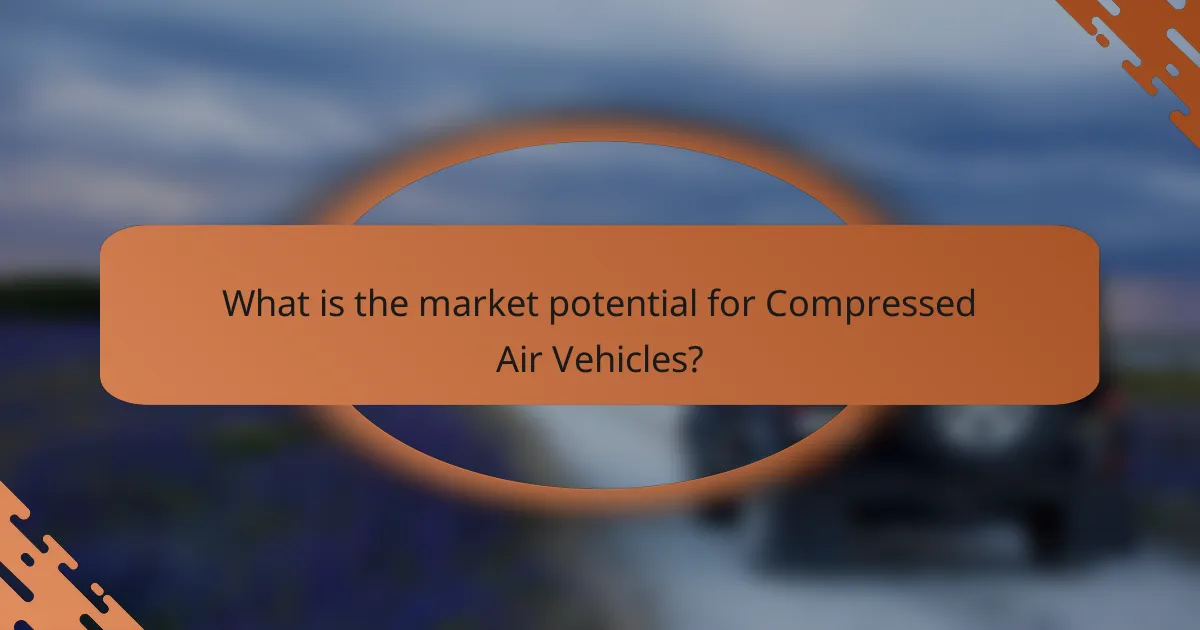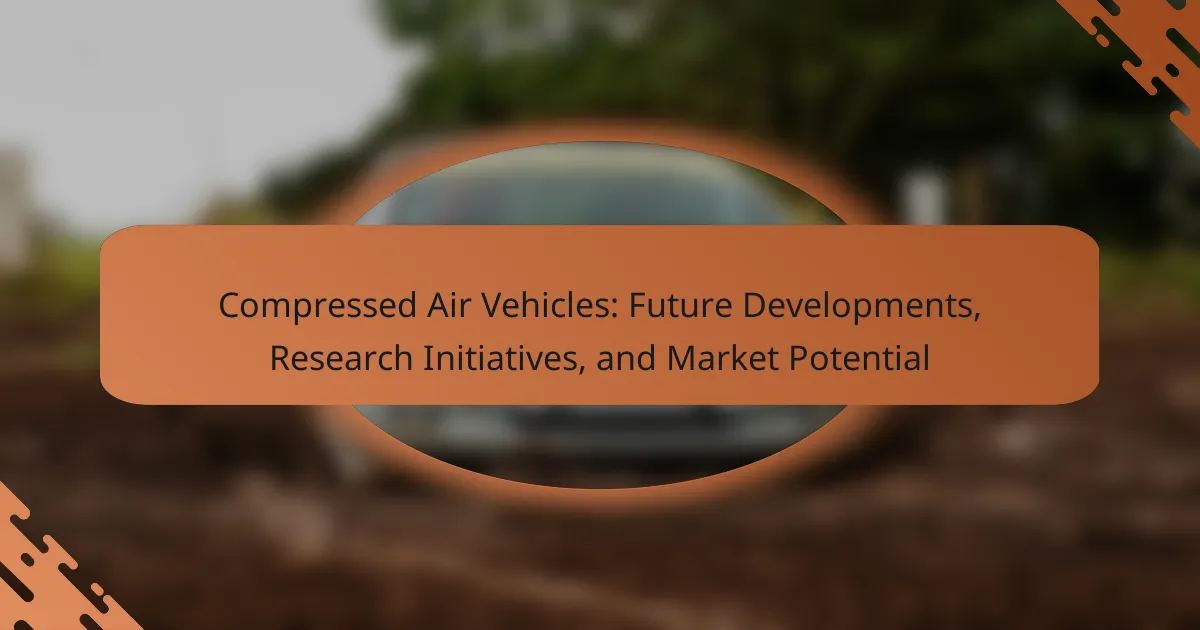Compressed air vehicles (CAVs) are innovative vehicles powered by compressed air, offering a sustainable alternative to traditional fossil fuel vehicles. These vehicles operate with zero emissions, contributing to environmental sustainability and reducing reliance on fossil fuels. Recent advancements in technology have spurred renewed interest in CAVs, with companies like MDI and Tata Motors developing prototypes that demonstrate improved efficiency and performance. As the global automotive market shifts towards greener technologies, the potential for CAVs to capture a share of the expanding market is significant, supported by increasing investments in research and development.

What are Compressed Air Vehicles?
Compressed air vehicles (CAVs) are vehicles powered by compressed air as a source of energy. They utilize compressed air stored in tanks to drive pistons or turbines that propel the vehicle. CAVs have the potential to reduce reliance on fossil fuels. They produce zero emissions during operation, contributing to environmental sustainability. The concept of CAVs has been explored since the late 19th century. Recent advancements in technology have renewed interest in their development. Companies like MDI and Tata Motors have been involved in creating prototypes. Research indicates that CAVs can offer a cost-effective alternative to traditional vehicles.
How do Compressed Air Vehicles function?
Compressed Air Vehicles (CAVs) function by using compressed air as a source of energy for propulsion. They store air at high pressure in tanks. When the vehicle operates, the compressed air is released through a motor. This release of air drives pistons or turbines, converting air pressure into mechanical energy. The mechanical energy then propels the vehicle forward. CAVs are designed to be environmentally friendly, producing no harmful emissions during operation. Research indicates that CAVs can achieve energy efficiency comparable to traditional vehicles. Additionally, advancements in tank materials and designs are enhancing their performance and safety.
What are the main components of Compressed Air Vehicles?
The main components of Compressed Air Vehicles include the air storage tank, compressor, engine, and control system. The air storage tank holds compressed air, providing the energy source for propulsion. The compressor is responsible for compressing air to high pressures for storage. The engine converts the energy from the compressed air into mechanical power for movement. The control system manages the operation of the vehicle, ensuring efficient use of air and power. Each component plays a crucial role in the overall functionality of the vehicle.
How is compressed air utilized in vehicle propulsion?
Compressed air is utilized in vehicle propulsion by converting stored air pressure into mechanical energy. This process occurs through an air engine that uses compressed air to drive pistons or turbines. The expansion of compressed air generates force, which propels the vehicle forward. Compressed air vehicles often feature lightweight designs to maximize efficiency. Research indicates that compressed air propulsion can reduce emissions compared to traditional fuel engines. For instance, a study by the International Journal of Energy Research highlights the potential of compressed air systems for sustainable transport. This technology is being explored as a viable alternative to fossil fuels in the automotive industry.
What are the advantages of Compressed Air Vehicles?
Compressed Air Vehicles (CAVs) offer several advantages. They produce zero emissions during operation, contributing to cleaner air quality. CAVs are also energy efficient, utilizing compressed air as a power source. This reduces dependence on fossil fuels. The vehicles generally have lower operational costs compared to traditional combustion engines. Maintenance is simplified due to fewer moving parts in the air propulsion system. Additionally, CAVs can be refueled quickly and easily at dedicated stations. This enhances convenience for users. Overall, these benefits position CAVs as a promising alternative in sustainable transportation.
How do Compressed Air Vehicles contribute to environmental sustainability?
Compressed Air Vehicles (CAVs) contribute to environmental sustainability by reducing greenhouse gas emissions. They operate using compressed air as a power source, which eliminates reliance on fossil fuels. This shift leads to a decrease in air pollution and carbon footprints associated with traditional vehicles. Additionally, CAVs can be powered by renewable energy sources during the air compression process. Studies indicate that CAVs can potentially reduce urban noise pollution due to their quieter operation compared to internal combustion engines. Furthermore, the use of CAVs promotes energy efficiency, as they can convert energy from compressed air into motion with minimal energy loss. This innovative approach aligns with global efforts to combat climate change and improve urban air quality.
What cost benefits do Compressed Air Vehicles offer to consumers?
Compressed Air Vehicles (CAVs) offer significant cost benefits to consumers primarily through reduced fuel costs. CAVs utilize compressed air as a power source, which is cheaper than traditional fuels. This leads to lower operational expenses over time. Additionally, CAVs require less maintenance compared to internal combustion engine vehicles. The absence of complex engine components reduces repair costs. Furthermore, CAVs can benefit from government incentives for clean energy vehicles. These incentives further decrease the overall cost of ownership. Research indicates that CAVs can achieve operational costs as low as $0.01 per mile. This is significantly lower than the average costs associated with gasoline or diesel vehicles.

What are the current developments in Compressed Air Vehicle technology?
Current developments in Compressed Air Vehicle technology focus on improving efficiency and performance. Researchers are exploring advanced materials for lighter tanks. Innovations in compressor designs aim to enhance air storage capacity. Companies are testing hybrid systems that combine compressed air with electric propulsion. Recent prototypes have demonstrated increased range and faster refueling times. Notable projects include those by the Air Car company and the development of the MDI Air Car. These advancements indicate a growing interest in sustainable transportation solutions.
What recent innovations have been made in Compressed Air Vehicles?
Recent innovations in compressed air vehicles include advancements in energy efficiency and vehicle design. Researchers have developed new compressed air storage systems that enhance energy density. These systems allow for longer driving ranges and improved performance. Additionally, lightweight materials are being utilized to reduce overall vehicle weight. This contributes to better fuel efficiency and handling. Companies are also exploring hybrid systems that combine compressed air with electric power. These innovations aim to make compressed air vehicles more viable in the automotive market.
How are manufacturers improving efficiency in Compressed Air Vehicles?
Manufacturers are improving efficiency in compressed air vehicles by enhancing energy storage systems. They are developing advanced compressed air tanks that optimize pressure retention. These tanks reduce energy loss during storage and improve overall vehicle range. Additionally, manufacturers are integrating lightweight materials to decrease vehicle weight. This reduction in weight allows for better energy efficiency and performance. They are also utilizing regenerative braking systems that capture energy during deceleration. This captured energy can be reused, further enhancing efficiency. Moreover, manufacturers are employing innovative designs that streamline airflow and reduce drag. These design improvements contribute to better aerodynamics and energy consumption. Overall, these advancements lead to significant gains in efficiency for compressed air vehicles.
What role does technology play in enhancing performance?
Technology significantly enhances performance in compressed air vehicles. Advanced engineering improves efficiency and reduces energy consumption. Innovations in materials lead to lighter and more durable vehicle structures. Enhanced control systems optimize the use of compressed air for propulsion. Real-time data analytics enable better performance monitoring and adjustments. Research indicates that these technologies can increase range and speed. For example, a study from the International Journal of Automotive Technology shows a 30% improvement in efficiency with new air compression techniques. These advancements drive the future market potential of compressed air vehicles.
What research initiatives are underway for Compressed Air Vehicles?
Current research initiatives for Compressed Air Vehicles (CAVs) focus on improving efficiency and performance. Researchers are exploring advanced materials to enhance the storage tanks. Studies are also investigating hybrid systems that combine compressed air with other energy sources. The University of Cambridge has developed a prototype demonstrating the potential for urban transport. Additionally, the European Union has funded projects aimed at integrating CAVs into existing transportation systems. Another initiative involves collaboration between automotive manufacturers and research institutions to optimize engine designs. These efforts aim to make CAVs a viable alternative to traditional vehicles.
Which institutions are leading research on Compressed Air Vehicles?
The institutions leading research on Compressed Air Vehicles include the Massachusetts Institute of Technology (MIT) and the University of California, Berkeley. MIT has conducted extensive studies on the efficiency and design of compressed air engines. Their research focuses on optimizing energy storage and propulsion systems. The University of California, Berkeley, is also involved in innovative projects related to air-powered transportation. They explore the feasibility and sustainability of compressed air technology in vehicles. Other notable institutions include the University of Southampton and the Indian Institute of Technology, which contribute to advancements in this field.
What are the key findings from recent studies on Compressed Air Vehicles?
Recent studies on compressed air vehicles (CAVs) reveal significant advancements in efficiency and design. Research indicates that CAVs can achieve a range of approximately 200 kilometers on a single charge of compressed air. Studies show that the energy efficiency of CAVs can reach up to 70%, which is competitive compared to traditional electric vehicles. Innovations in lightweight materials have improved the vehicle’s overall performance and reduced energy consumption. Additionally, research highlights the potential for lower operational costs, with estimates suggesting a 30% reduction compared to gasoline vehicles. The studies emphasize the environmental benefits, noting that CAVs produce zero tailpipe emissions. Furthermore, advancements in storage technology have enhanced the safety and reliability of compressed air systems. These findings collectively suggest a promising future for compressed air vehicles in the automotive market.

What is the market potential for Compressed Air Vehicles?
The market potential for Compressed Air Vehicles (CAVs) is significant. This potential is driven by increasing demand for sustainable transportation solutions. CAVs offer a cleaner alternative to traditional fossil fuel vehicles. They produce zero emissions during operation, aligning with global environmental goals. The global automotive market is shifting towards greener technologies. According to a report by the International Energy Agency, electric and alternative fuel vehicles are projected to grow substantially by 2030. CAVs could capture a share of this expanding market. Additionally, advancements in compressed air technology may enhance vehicle performance and efficiency. The rising investment in research and development further supports the market’s growth trajectory.
What trends are influencing the market for Compressed Air Vehicles?
Growing environmental concerns are influencing the market for Compressed Air Vehicles (CAVs). Consumers increasingly prefer sustainable transportation options. This trend is driven by the push for reduced carbon emissions. Government regulations are also promoting cleaner technologies. Investment in research and development for CAVs is on the rise. Companies are exploring innovative designs to improve efficiency. Additionally, advancements in compressed air technology are enhancing vehicle performance. These factors collectively shape the future of the CAV market.
How is consumer demand shaping the future of Compressed Air Vehicles?
Consumer demand is driving innovation and investment in Compressed Air Vehicles (CAVs). As environmental concerns rise, consumers increasingly seek sustainable transportation options. This demand influences manufacturers to develop more efficient and eco-friendly CAV technology. Additionally, consumer preferences for cost-effective solutions push companies to enhance performance and reduce production costs. Market research indicates that a growing segment of consumers prioritizes zero-emission vehicles, further motivating the industry. According to a 2022 report by the International Energy Agency, the demand for alternative fuel vehicles, including CAVs, is projected to increase significantly by 2030. This trend compels automakers to adapt their strategies to meet evolving consumer expectations. As a result, the future of CAVs is closely tied to consumer preferences and market dynamics.
What challenges does the market face for widespread adoption?
The market for compressed air vehicles faces several challenges for widespread adoption. Limited infrastructure for refueling compressed air vehicles is a significant barrier. Current refueling stations are not widely available, hindering convenience for users. Additionally, the technology is still in developmental stages, which affects consumer confidence. High initial costs for manufacturing and purchasing compressed air vehicles also deter potential buyers. Furthermore, regulatory hurdles related to safety and emissions standards complicate market entry. Lastly, competition from established fuel technologies creates resistance to new alternatives. These challenges must be addressed to facilitate broader acceptance and integration of compressed air vehicles into the market.
What are the future prospects for Compressed Air Vehicles?
The future prospects for compressed air vehicles (CAVs) are promising but face significant challenges. CAVs offer a sustainable alternative to traditional fuel vehicles. They utilize compressed air as a power source, reducing greenhouse gas emissions. Research indicates that advancements in air storage technology can enhance vehicle efficiency. For instance, a study by the University of California, Davis, highlights improvements in energy density. Market interest is growing due to rising environmental concerns. However, infrastructure development for CAVs remains limited. The cost of manufacturing and potential range limitations also pose challenges. Overall, while the potential is significant, further innovation and investment are essential for widespread adoption.
How might government policies impact the growth of Compressed Air Vehicles?
Government policies can significantly impact the growth of Compressed Air Vehicles (CAVs). Supportive regulations can foster innovation and investment in CAV technology. Incentives such as tax breaks or subsidies encourage manufacturers to develop and produce CAVs. Additionally, government mandates for emissions reductions can create a market for cleaner vehicle technologies like CAVs.
Conversely, stringent regulations can hinder growth if compliance costs are too high. Infrastructure development policies also play a crucial role. Investments in refueling stations for CAVs can enhance their market viability. Countries with clear policies promoting alternative fuel vehicles often see faster adoption rates.
For instance, the European Union has implemented policies aimed at reducing carbon emissions, which supports the growth of CAVs. The U.S. government has also offered grants for research into alternative fuel technologies, including CAVs. These examples illustrate the direct correlation between government policies and the advancement of Compressed Air Vehicles.
What predictions can be made about the evolution of Compressed Air Vehicles?
Predictions about the evolution of Compressed Air Vehicles (CAVs) indicate significant advancements in technology and market adoption. CAVs are expected to become more efficient as research progresses. Innovations in materials and design will likely enhance their performance and reduce costs. Increased environmental awareness will drive demand for cleaner transportation options. Government regulations may promote the development and use of CAVs. Several companies are already investing in this technology, indicating strong market potential. For instance, the Air Car by the company MDI showcases the practical application of compressed air propulsion. Continued advancements in energy storage and compression technology will further support the growth of CAVs.
What best practices should consumers consider when evaluating Compressed Air Vehicles?
Consumers should consider several best practices when evaluating Compressed Air Vehicles (CAVs). First, assess the vehicle’s energy efficiency. CAVs should ideally convert compressed air to kinetic energy with minimal loss. Second, examine the vehicle’s range. A longer range indicates better usability for daily transportation needs. Third, review the refueling infrastructure. Availability of refueling stations is crucial for convenience. Fourth, investigate the vehicle’s maintenance requirements. Lower maintenance needs can enhance long-term ownership satisfaction. Fifth, analyze safety features. A robust safety profile is essential for consumer confidence. Lastly, consider the manufacturer’s reputation. Established brands may offer more reliable products and service support. These practices help ensure informed decision-making when selecting a CAV.
Compressed air vehicles (CAVs) are innovative transportation solutions that utilize compressed air as a power source, offering zero emissions and reduced reliance on fossil fuels. This article explores the functionality, components, and advantages of CAVs, including their contribution to environmental sustainability and cost benefits for consumers. It also highlights current technological developments, research initiatives, and market potential, addressing both challenges and future prospects for widespread adoption. Key findings from recent studies indicate significant advancements in efficiency, design, and consumer demand that shape the future of compressed air vehicles.
